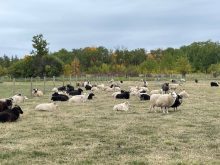Eureka! Not really. In the next year or so, Syngenta will release a hybrid wheat variety using complex crossbreeding systems just ahead of a few rival companies working on the same problem.
Hybrid wheat varieties combine the traits of two parent selections. Work started on hybrid wheat around 2010, and by 2023 there will be sufficient hybrid wheat seed to plant around 6,000 acres in the United States.
As we know, growers of corn, canola and soybeans have long benefitted from hybridization of these crops to boost yields, and there has been a general acceptance by the public.
Read Also

Claas brings 1000 Series SP forage harvesters to Canada
In mid-August, Claas unveiled its new line of Jaguar forage harvesters at an event in Visalia, California, deep in the heart of that state’s dairy region.
Hybrid wheat varieties must be adaptable for local growing conditions, disease tolerance and meet standards for milling and baking.
Syngenta’s new hybrid wheat variety will be sold in the United States under the AgriPro brand, and it is said to increase yields by as much as 15 per cent over conventional varieties.
If we look at corn hybrids, for example, yield increases have been phenomenal. In the 1930s and ’40s, corn yields were 25 to 40 bushels per acre. With these new hybrids and proper fertility, irrigation and weed, insect and disease control, corn yields average around 150 bu./ac. Plant breeders like to take full credit for the yield increases, but it’s the full agronomic package that has vastly increased corn yields.
Major companies like Bayer AG and BASF SE are also working on developing hybrid wheat but are a few years behind. Crop hybridization, as used by Syngenta in the case of hybrid wheat, must be acceptable to the general public since it’s going to end up as bread or pasta.
Genetic modification used for crop hybridization, as in corn and soybeans, is somewhat controversial, so breeders have shied away from doing this with wheat. Even so, a drought-tolerant wheat developed in Argentina using genetic modification has been accepted in several countries such as Brazil and Nigeria, which face struggles to feed growing populations as a consequence of increasingly unpredictable weather.
To date, producers in Minnesota have grown up to 80 acres of grain for feed and smaller acreages for seed with positive best yield results, but they are somewhat skeptical about the extra cost of production of the hybrid seed.
Growing commercial hybrid wheat in 2023
Syngenta states there will be enough hybrid seed for U.S. farmers to grow around 6,000 acres. U.S. farmers who grow this hybrid wheat in 2023 will receive a discount on seed to encourage feedback. The company hopes there will be enough seed for a full commercial launch in 2024.
BASF plans to launch a hybrid wheat variety in Europe in 2025 or later as will Bayer in Europe and the United States. Bayer has said it has seen yield increases in its hybrid wheat of about 15 per cent or more in regional trials. Hybrid wheat has been an objective with wheat breeders for more than 70 years, but results have not been entirely satisfying.
Breeding hybrid wheat
Apparently, you plant a mixture of male and female plants in an open field and surround them with a border of male plants to ensure effective pollinators.
I am somewhat skeptical about this hybridization procedure since it is well known female wheat flowers that open are subject to ergot infection as well as stray wheat pollen, which can travel a couple of miles.
Ergots could replace grains and stray pollen from regular wheat plants could produce undesirable cross-pollination. Conventional wheat varieties are closed pollinated and, therefore, cannot be infected with ergot spores or stray pollen.
Technically, ergot could be easily cleaned out of hybrid wheat. Ergot in wheat was a problem in the U.K. in the 1980s when researchers grew male sterile wheat varieties and ended up with major levels of ergot along with the cross-pollinated grain. Copper fertility would not prevent ergot infection in this instance since the wheat flowers open. They are no longer closed pollinated.
Salvation for hybrid wheat?
Do you know what apomixis is? Apomixis is a common plant process that produces seeds genetically identical to the mother plant. This enables a plant with a desirable combination of traits to produce offspring with the same desirable combination of genes as the mother plant.
In nature, this happens fully or partially with plants like dandelions, oranges and saskatoons. The plants may appear to be pollinated but the mother plant cells take over the developing embryo so that it’s an exact copy of the mother plant.
Researchers at Wageningen University in the Netherlands (Holland), Japan and New Zealand have discovered a gene that will make it possible to produce seeds in crops genetically identical to the mother plant. This process is called apomixis.
The gene they identified is named PAR, which is short for parthenogenesis. This is the process whereby the egg or seed cell grows into plant embryos without fertilization (pollination) of the egg cell. This represents 15 years of work on a program called KeyGene.
This apomictic process, if successful, allows superior combinations of plant traits to be captured and preserved without any cross-pollination. Apomixis could accelerate breeding of innovative crops and reduce the cost of seed production.
These PAR genes are present in all plants, and around 400 wild plant species are known to be apomictic. In most other plant species, the PAR gene could be incorporated into selected crops and be switched on prior to fertilization. With apomixis, we can preserve the traits of superior crop plants.
This work is still in its early stages, but it might solve and facilitate the production of superior-yielding hybrid crops such as wheat, barley and oats.
















